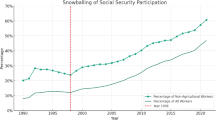Conclusion
The aim of this study was to examine the tariff structure in Israel in terms of the four main theoretical models of endogenous commercial policy. The empirical results for levels of protection in Israel support several of the models. In particular the pressure group model performs well and especially the variable that represents the lobbying power of the Histadrut/public sector in Israel. This is consistent with the longstanding political power of the Histadrut in Israel. The Histadrut's role in the Israeli economy rises above the “western” concept of a labor union and takes on a quasi-governmental function. The clearest example of this elevated status is seen when the government included the Histadrut as part of the commission charged with the responsibility of carrying out the “nominal liberalization” process of the 1960s. Evidently it is this kind of political-economic power that allowed the Histadrut to affect the level of protection Histadrut-dominated industries received.
The displacement costs model is also supported suggesting that officials, when deciding on tariff rates, are sensitive to the displacement costs (e.g., amount and average duration of unemployment), associated with different levels of protection for various industries. This result stands in contrast to the goals set out in the “New Economics Policy” of 1962 discussed earlier. Apparently tariff setting authorities desired to increase efficiency by reducing protection but were also willing, perhaps for political reasons, to trade off lower displacement costs with higher tariff rates.
The status quo and comparative disadvantage models, however, are not supported. This seems to reflect the sincerity of the tariff setting authorities in reducing the overall level of protection in Israel in order to increase efficiency via competition and better resource allocation. None of the models, though, are supported when tested for changes in protection.
One drawback to this analysis is the fact that, despite enactment of the trade liberalization policies in the 1960s, quantitative restrictions continued to play a role in many industries throughout this period. This being the case, then the protective role of tariffs is somewhat diminished. This weakness gives rise to an obvious extension to the current analysis. Namely, quantity restrictions could be converted into their tariff equivalents and then added to the overall level of industry protection. Unfortunately, at present, data on quantity restrictions in Israel is not made publicly available. Despite this drawback, however, the above analysis has provided some interesting results and has demonstrated the success of several of the theoretical models in describing tariff formation in Israel.
Similar content being viewed by others
References
Anderson, K. and Baldwin, R. (1981). The political market for protection in industrial countries. Staff Working Paper No. 492, World Bank.
Balassa, B. (1978). The market penetration studies: Approach and methodologies. Mimeo. Paper presented to the first World Bank meeting of participants in the “Market Penetration” research project, 5–7 December, Brussels.
Baldwin, R.E. (1985). The political economy of U.S. import policy. Cambridge, MA: MIT Press.
Baldwin, R.E. and Mutti, J.H. (1973). With comments by D. Hinton and D. Balassa, Policy issues in adjustment assistance: The United States. In H. Hughes (Ed.), Prospects for partnership, 149–186. Baltimore: John Hopkins University Press.
Bar-Nathan, M. and Baruh, J. (1990). Determinants of the tariff structure of the Israeli industrial sector 1965–1977. Journal of Development Economics 33: 19–30.
Brock, W.A. and Magee, S.P. (1978). The economics of special interest politics: The case of the tariff. The American Economic Review 78.2 (May): 246–250.
Caves, R.E. (1976). Economic models of political choice: Canada's tariff structure. Canadian Journal of Economics 9.2: 278–300.
Cheh, J.H. (1974). United States concessions in the Kennedy Round and Short-run adjustment costs. Journal of International Economics 4.4: 323–340.
Fein, L.J. (1967). Politics in Israel. Boston: Little Brown.
Findlay, R.I. and Wellisz, S. (1982). Endogenous tariffs, the political economy of trade restrictions, and welfare. In J. Bhagwati (Ed.), Import competition and response, 238–243. Chicago: University of Chicago Press (for NBER).
Hillman, A.L. (1988). Impediments to a competitive environment in Isarel. Paper prepared for the “American Israel Symposium on American-Israeli Economic Relations to Mark the Fortieth Anniversary of the State of Israel,” St. Regis Sheraton Hotel, New York, 5–7 June 1988.
Hillman, A.L. (1989). The political economy of protectionism. Chur, Switzerland: Harwood Academic Press.
Hillman, A.L. (1991). Liberalization dilemmas. In A. Hillman (Ed.), Markets and politicians, 189–207. Dordrecht: Kluwer Academic Publishers.
Hillman, A.L. (1992). International trade policy in Israel: Another model. Public Choice 74: 355–360.
Hillman, A.L. and Ursprung, H. (1988). Domestic politics, foreign interests, and international trade policy. The American Economic Review 78: 729–745.
Lavergne, R.P. (1983). The political economy of U.S. tariffs: An empirical analysis. New York: Academic Press.
Mayer, W. (1984). Endogenous tariff formation. The American Economic Review 74: 970–985.
Michaely, M. (1975). Foreign trade regimes and economic development: Israel. New York: Columbia University Press (for NBER).
Olson, M. (1965). The logic of collective action. Cambridge, MA: Harvard University Press.
Pincus, J.J. (1977). Pressure groups and politics in antebellum tariffs. New York: Columbia University Press.
Tov, L. (1971). Import liberalization policy in Israel, 1962–67. Economic Review. Bank of Israel: 28–51.
Author information
Authors and Affiliations
Additional information
This paper was written while I was visiting at Tel Aviv University, Israel. I wish to thank Gideon Fishelson, June Flanders, Stanislaw Wellisz, Arye Hillman, Douglas Holtz-Eakin, Ronald Findlay, Todd Idson and an anonymous referee for their insightful comments on earlier drafts. I would also like to thank Joseph Baruh and Moshe Bar-Nathan of the Bank of Israel for supplying me with data.
Rights and permissions
About this article
Cite this article
Kahane, L.H. The political economy of Israeli protectionism: An empirical analysis. Public Choice 74, 339–353 (1992). https://doi.org/10.1007/BF00149183
Accepted:
Issue Date:
DOI: https://doi.org/10.1007/BF00149183




